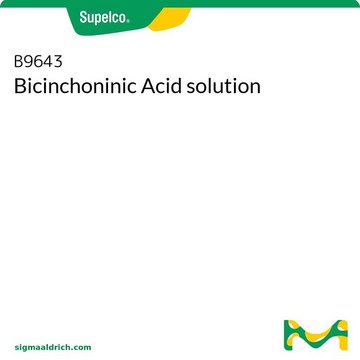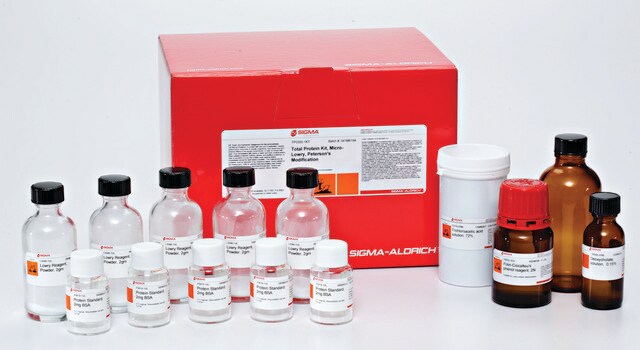QPBCA
QuantiPro™ BCA Assay Kit
for 0.5-30 μg/ml protein
Sinónimos:
BCA Assay, Protein determination by BCA, bicinchoninic acid reagent
About This Item
Productos recomendados
Application
Features and Benefits
- Accurate across a broad range of protein concentrations
- High sensitivity; linear response form 0.5 to 30 μg/ml of protein
- Stable color complex
- Reduced susceptibility to detergents
Principle
Storage and Stability
Legal Information
Solo componentes del kit
- Copper(II) sulfate solution, 4 % (w/v) (prepared from copper (II) sulfate pentahydrate) 12 mL
Los componentes del kit también están disponibles por separado
- P0914Protein Standard Solution: 1.0 mg/ml bovine serum albumin in 0.15 M NaCl with 0.05% sodium azide (flame-sealed glass ampules) 10 x 1SDS
Application
Related product
signalword
Danger
hcodes
Hazard Classifications
Aquatic Acute 1 - Aquatic Chronic 1 - Eye Dam. 1 - Met. Corr. 1 - Skin Irrit. 2
Storage Class
8A - Combustible corrosive hazardous materials
Certificados de análisis (COA)
Busque Certificados de análisis (COA) introduciendo el número de lote del producto. Los números de lote se encuentran en la etiqueta del producto después de las palabras «Lot» o «Batch»
¿Ya tiene este producto?
Encuentre la documentación para los productos que ha comprado recientemente en la Biblioteca de documentos.
Artículos
The era of high-throughput proteomics has recently blossomed due in large part to advances in the methods by which proteins and proteomes are analyzed. Improved fractionation techniques, combined with advances in mass spectrometry, have decreased concerns of sample complexity, and directed more focus towards high-throughput techniques.
This page describes common challenges encountered when lysing cells and extracting proteins prior to Western blotting. Total protein concentration must be determined for these cell lysates. Variables affecting each of these steps are outlined below, as each could affect the sensitivity and reproducibility of the Western blot.
The possible causes and potential remedies for challenges encountered in the immunoprecipitation-Western blot technique, which consists of cell lysis, formation of the antibody-antigen (immune) complex, precipitation of the immune complexes, and analysis by Western blotting.
The possible causes and potential remedies for challenges encountered during preparation of samples for SDS-PAGE (sodium dodecyl sulfate polyacrylamide gel electrophoresis) and optimizing electrophoresis conditions.
Contenido relacionado
Protein quantification methods, reagents, and immunoassay technology for accurately measuring the protein concentrations in a variety of samples.
A wide variety of products for traditional protein quantitation techniques such as BCA and Bradford. Also, products for alternative assays such as Lowry, Micro Pyrogallol and FluoroProfile are also available for total protein determination.
Nuestro equipo de científicos tiene experiencia en todas las áreas de investigación: Ciencias de la vida, Ciencia de los materiales, Síntesis química, Cromatografía, Analítica y muchas otras.
Póngase en contacto con el Servicio técnico









